Most restaurants and cafes use more than one type of commercial refrigeration. Hence, finding the most suitable one for your kitchen in terms of size, utility, compressor, door type, and other parameters might sound like a challenge because many different models have various features.
Reach-in refrigerations are among the most used items in commercial kitchens of restaurants, cafes, pizzerias, and other food-serving establishments. While improving the quality of service, reach-in refrigerators and freezers can help you save energy, food, and money. However, buying reach-in refrigeration for a commercial kitchen is a big deal for a food business since it requires a significant amount of money to be invested.
Here, we have created a comprehensive guide for choosing the best reach-in refrigeration system, one of the most preferred types in commercial refrigeration, to fit your needs. We intend to present a detailed guide to consider all conditions and factors influencing efficiency and practicality. Because making a wrong purchase might end up more costly than what you initially spent on your reach-in refrigeration. But making the right choice will undoubtedly pay off its investment by saving you time and money in the long run.
1. Why Do You Need Reach-in Refrigeration For Your Food Serving Business?
Like their counterparts in residential areas, reach-in refrigeration is designed to serve in commercial kitchen’s back-of-the-house. The reach-in refrigerators and reach-in freezers are primarily intended to store, cool, freeze and preserve the food products, ingredients, dairies, fruits, and vegetables until you use them. Because of their versatility, practicality, cost, and efficiency, reach-in coolers and reach-in freezers are the most preferred options for commercial refrigeration.
Reach-in refrigerations are the equipment of choice, not only commercially but also residential. But of course, there are significant differences between them. Firstly, the residential coolers and freezers are appropriate for meeting the requirements of a family. These types of reach-in refrigerators and freezers can only handle a limited number of openings. It will soon start to beep to warn you about the rising interior temperature because the hardware of these units is not capable enough to maintain the inner chill for a long time when the doors are open.
Nonetheless, the reach-in refrigeration systems are precisely planned to handle such conditions. They boast more powerful regulators, compressors, and improved insulation to maintain inside chilling or freezing despite numerous openings and closings even during peak hours. Additionally, reach-in coolers and freezers are equipped with different systems to measure and stabilize the temperature in the cabin more precisely. This prevents temperature fluctuations and probable food spoils and bacteria growth in the stored foodstuff.
Secondly, reach-in refrigerations are manufactured from stainless steel to ensure durability and longtime service in heavy conditions. In addition, they are designed to work harder and consistently to improve work efficiency and sustain the smooth running of a kitchen. But the residential ones are vulnerable to these abuses, and they will easily be broken soon. It is highly possible to find necessary accessories and spare parts for the reach-in refrigeration even long after the initial purchase. However, residential units will not possibly have such an opportunity.
2. What to Consider When Buying a Reach-in Refrigerator or Freezer?
Several factors should be taken into consideration while looking for a reach-in refrigeration unit. The factors that are explained below will affect their initial price, work efficiency, and operating expenses.
a. Available Space
Reach-in refrigerations are manufactured with different capacities, and hence, their height, width, and depth can vary. Thus, you need to plan and evaluate your available space in your commercial kitchen. The ceiling height, floor area, and kitchen layout are all effective in this decision. You should also allocate enough room for the staff to work and maneuver around.
b. Working Conditions
Although reach-in refrigerators and freezers are suitable for commercial kitchens, where you put them also affects the efficiency and running performance. Putting these reach-in refrigeration systems near cooking equipment such as an oven or a range will undoubtedly increase energy consumption. Or, if you need a reach-in refrigerator or freezer next to your fryer or other commercial cooking equipment, you may want to opt for more powerful models.
c. Providing Enough Airflow
The airflow for the reach-in refrigeration units needs to be stable and sufficient to cool down their parts and the interior. Hence, there should be at least a two-inch-wide airgap to supply enough airflow. Furthermore, you should also be careful not to place other equipment too close to the reach-in coolers and freezers to avoid hindering the airflow to the reach-in refrigeration systems, which may result in their malfunction.
Additionally, reach-in refrigeration units also need space for air conditioning and circulation inside the fridge or the freezer. Therefore, you should abstain from obstructing the inner air circulation by too much stacking inside.
d. Gaskets
Gaskets are the rubber insulation elements that ensure the complete closing of the doors. They fill even the tiny gaps and contribute to the insulation and retaining the interior chill. However, these gaskets gradually wear off due to the numerous openings and beatings, and it is essential to renew them when needed to prevent malfunctioning and loss of efficiency. Your commercial kitchen can be too busy, and your kitchen equipment can incur too frequent use. So, you should opt for reach-in refrigeration systems with removable gaskets, which facilitate and accelerate cleaning, sanitation, and renewal.
e. Maintenance
When the high initial cost and the critical role of these reach-in refrigeration systems for the food serving businesses are taken into account, it is pretty clear that maximum efficiency and the most extended service are the principal expectations from these pieces of kitchen equipment. Maintaining and cleaning them regularly is vital to attain the utmost efficiency and benefit from a reach-in cooler or a freezer. You should be knowledgeable about this when purchasing those as well.
f. Material
Nonetheless, it should also be noted that vendors provide both economic and top-of-the-line products, which vary in the materials used In the manufacturing. The economic models are produced from the combination of stainless steel and aluminum. Reach-in refrigeration units are mainly made of stainless steel. The exterior part of these units is generally made of stainless steel, and the inner parts are often made from aluminum. But, the spec line or the high-end units are made from stainless steel both in the exterior and interior.
g. Mobility
Even though these reach-in refrigeration systems are large and heavy equipment, they can also be equipped with sturdy casters and can be moved to different places in your back-of-the-house for versatile use. They can also facilitate cleaning and maintenance by opening the space on which they usually stand.
h. Digital Thermostats
Due to their large regulators and compressors, reach-in refrigerators can keep the interior chill and cold stable. But digital thermostats are the state-of-the-art gift of technology to reach-in refrigeration, and they provide you with more accurate temperature monitoring and more precise control over cooling and freezing.
i. Energy Saving
Utility bills can run high in commercial kitchens. If your kitchen is big enough, you can organize your appliances depending on their heat production to save some energy. Reach-in refrigerators and freezers use the air around them. If the air is hot, it will work harder to cool it down and use more power. The best way to organize your kitchen is to have all your appliances line up from the hottest to the coolest. You can also decrease your energy bills by opting to purchase an ENERGY STAR certified reach-in refrigeration unit.
3. What to Know Before Deciding on Purchasing a Reach-in Refrigeration System?
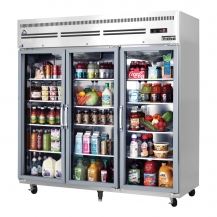
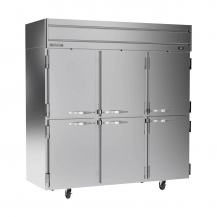
In addition to the primary factors that determine the suitability of a reach-in refrigeration unit for your commercial kitchen, you should also be aware of the various features of this type of kitchen equipment to make the best decision.
a. Door Types
Reach-in refrigerations present two options of doors that offer different advantages, as explained below.
| Solid Door | Glass Door |
| Advantages * More energy efficient, * Better insulated, * Easier and faster cleaning. Disadvantages * No see-through and visibility loss for product selection | Advantages * Seeing the products without opening the doors, * Keeping the cold inside with fewer door openings, * Less interior cold loss. Disadvantages * Less insulation, * Often need for cleaning. |
b. Condenser System
Reach-in refrigerations come with two different types of condensers. The first type is the self-contained systems installed inside the cabinet of the reach-in fridge or the reach-in freezer. These are the most preferred models as they do not need additional purchases, tubes, or technicians. Thus, they can be installed and moved easily and quickly.
However, this system is also a source of heat and noise because the system is all set up in the kitchen. There are also coolers whose condensers are placed in a different space, and the cooling is carried out through the pipes transmitting the cold air. These units offer more storage space and less noise and heat inside the building while they require more professional maintenance, consume more energy, and want more time and work to install or move.
c. Compressor Location
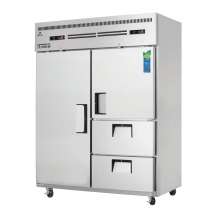
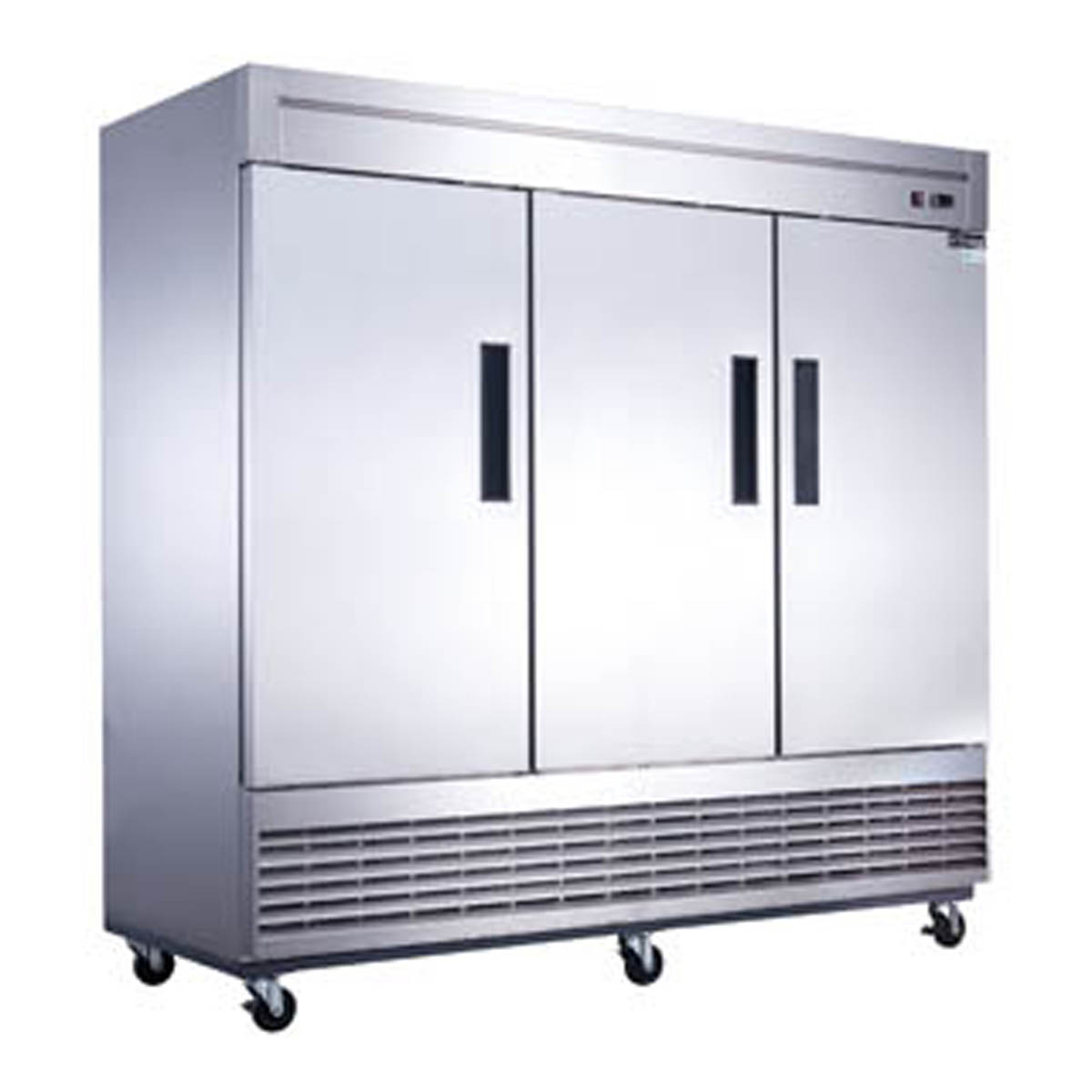
Compressors are one of the reach-in refrigeration units’ main components, and they carry out air compression and airflow regulation. Initially, it should be kept in mind that the warm air is lighter than the cold air. Thus, the warm air soars up gradually. Therefore, compressor location and environmental conditions are also of importance for the performance of the reach-in refrigeration units. There are two principal types of refrigerator and freezer compressor as follows:
| Bottom Mounted | Top Mounted |
| Advantages * Using cooler air for running, * More comfortable working with elevated bottom shelves, * More suitable for kitchens with a low ceiling, * Appropriate for hotter environments. Disadvantages * Less space for storage, * Possible clogging by the dust, grease, and food ingredients. | Advantages * Using warmer air to cool, * More appropriate for cooler places, * Less clogging probability, * More storage room. Disadvantages * More arduous cleaning and service, * Need for larger installation space. |
d. Door Opening
The opening style of the door is also a significant issue to consider when buying a reach-in refrigeration system. While swinging doors offer a larger reach-in, the sliding doors are space-saving and anti-congestion options to open up more working space on limited kitchen floors. Furthermore, sliding doors are relatively harder to load and unload despite the easy access to the interior through the swinging doors.
If you like swing doors but prefer to have both options for your reach-in refrigeration system, half doors are perfect for your restaurant. You can save some energy and money as you do not decrease the interior temperature of the unopened side of the reach-in refrigerator and freezer.
Additionally, if you need a refrigeration unit between your prep areas and serving locations, pass-thru doors are the ones to go with. The double-sided doors allow the user to reach inside the commercial refrigeration units from both ends of them. Moreover, pass-thru doors speed up the service times and come with various materials for the doors.
4. What To Use Where?
Reach-in refrigeration units also offer options for the number of available compartments. These options are named according to the total number of doors a reach-in refrigeration unit has.
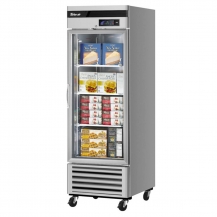
a. One Door Reach-in Refrigeration Units
- Best to keep next to the cooking area.
- Smaller portioned of prepared dishes, meats, garnishes, and sauces.
- Restock from the walk-in store or the 2-3 door reach-in weekly.
- Quicker access that enables faster service times.
b. 2-3 Door Reach-in Refrigeration Units
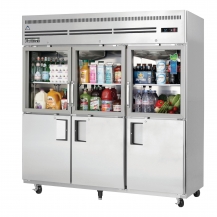
- Inside of the prep area.
- To store prepared, bulk items like seasoned meat, seasoned fish, or other produce.
- Sauces and dressings that will be used throughout the week.
- Weekly restocking from the walk-in or the grocery store.
- Large storage space.
5. How To Install A Reach-in Refrigeration

There are certain things to consider when it comes to installing your reach-in refrigerator and reach-in freezer. The last thing any chef wants is their refrigerator or freezer breaking down. To prevent such a thing from happening, you need to install the unit correctly.
- Make sure to check where and how you will install the unit.
- Measure the door frames and hallways to ensure the unit will fit through the door.
- Remember that larger units may not fit through standard doorways and will need to be planned out while the building is in construction.
- Larger units will need more air, so make sure the room in the reach-in refrigerator is well ventilated.
- Manufacturers will usually have guidelines on the details you will need.
- Reach-in refrigeration compressors suck in the air around them, cool it, and use that to keep the inside cold. Exceptionally humid or dusty areas will cause the units not to work as efficiently and clog up the compressor.
- Check the surface you will be setting up your unit. The floor needs to be leveled and away from moisture-generating equipment.
- Always check and make sure to use the proper voltage that the manufacturer suggests and that the reach-in refrigerator and freezer have their electrical circuit.
6. How to Extend the Service Time Of Reach-in Refrigeration System?
Reach-in refrigerations are vital to keeping your kitchen running, preventing food squander, and avoiding wasting money. Thus, you should be carrying out a regular, steady, and careful cleaning and maintenance of your reach-in refrigeration to maximize its efficiency and prolong its service time. You can basically apply the following steps to make the most out of your reach-in refrigeration investment.
- Form a weekly cleaning sanitation routine for the reach-in refrigeration. Start with cleaning the surface, removing and cleaning the shelves, washing the gaskets, and sanitizing the exterior.
- Remember to add the condenser coil to your cleaning routine at least once in three months,
- Check the evaporator coil (next to the evaporator fan) regularly,
- Check and clean the drain pans and tubes,
- Check the air filters and make sure that it works. Clean it with degreasing solutions regularly,
- Watch the gaskets, clean them by removing and renewing them when needed.
- Check the water accumulation at the bottom and if you see a frequent water gathering, look for its reason.
- Repair and fix the worn-out and damaged parts.
Conclusion
Reach-in refrigeration systems are among the essential components of a commercial kitchen. Therefore, regardless of its size and capacity, every type of food business should get one to ensure a smooth workflow in their business. Notwithstanding the higher initial investment cost compared to the residential units, these reach-in refrigeration units are chiefly designed to suit the needs of a commercial kitchen. They will compensate and return the initial cost by saving you time and money while keeping your valuable food ingredients and prepared meals and desserts healthy, tasty, and fresh. We are sure that you will find a suitable reach-in refrigeration unit for your business with this detailed buying guide.

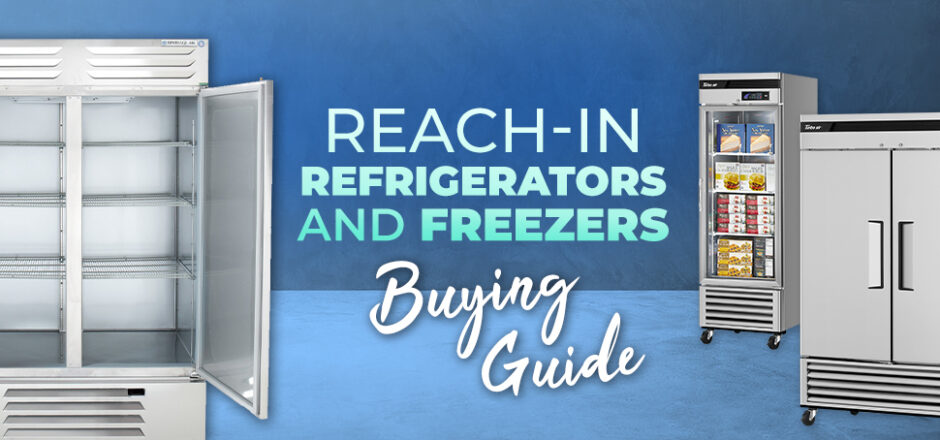


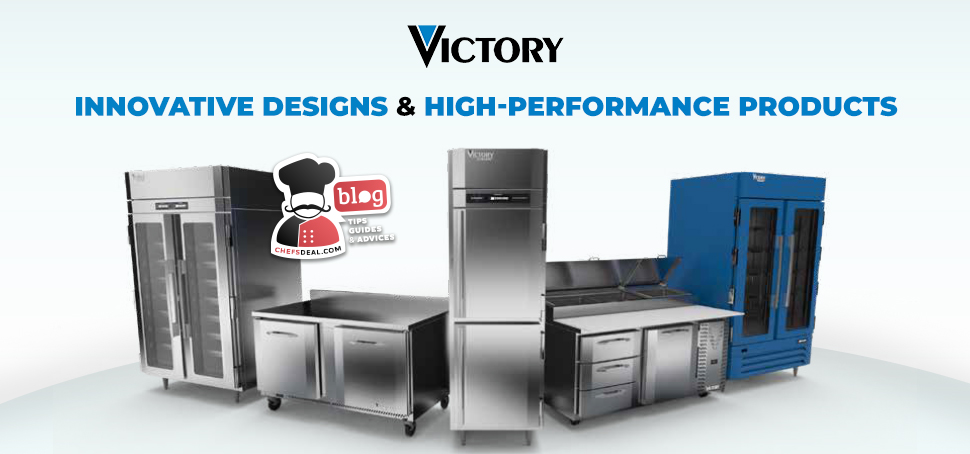

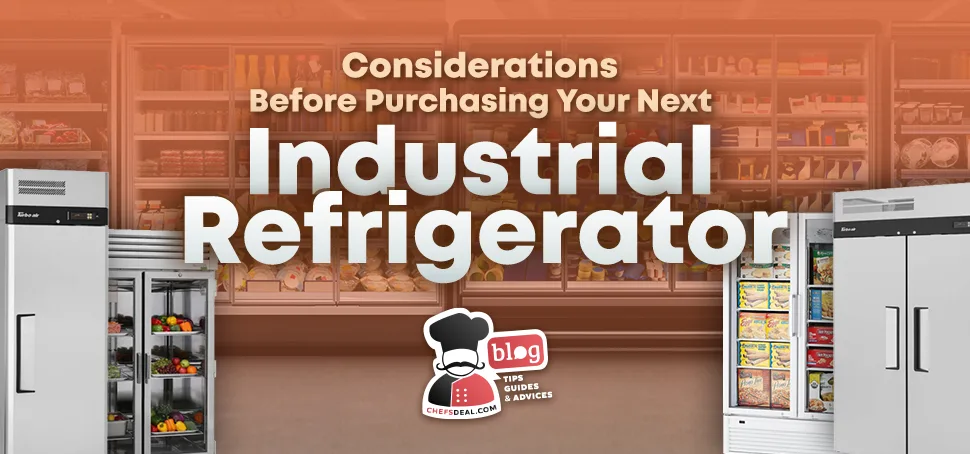
3 comments On Reach-in Refrigeration Buying Guide
Pingback: Quick Tips For ADA Compliant Refrigerators - Chef’s Deal ()
Pingback: Bakery Equipment List in 4 Main Categories - Chef's Deal ()
Pingback: The Best Coffee Shop Equipment List in 5 Steps - Chef's Deal ()